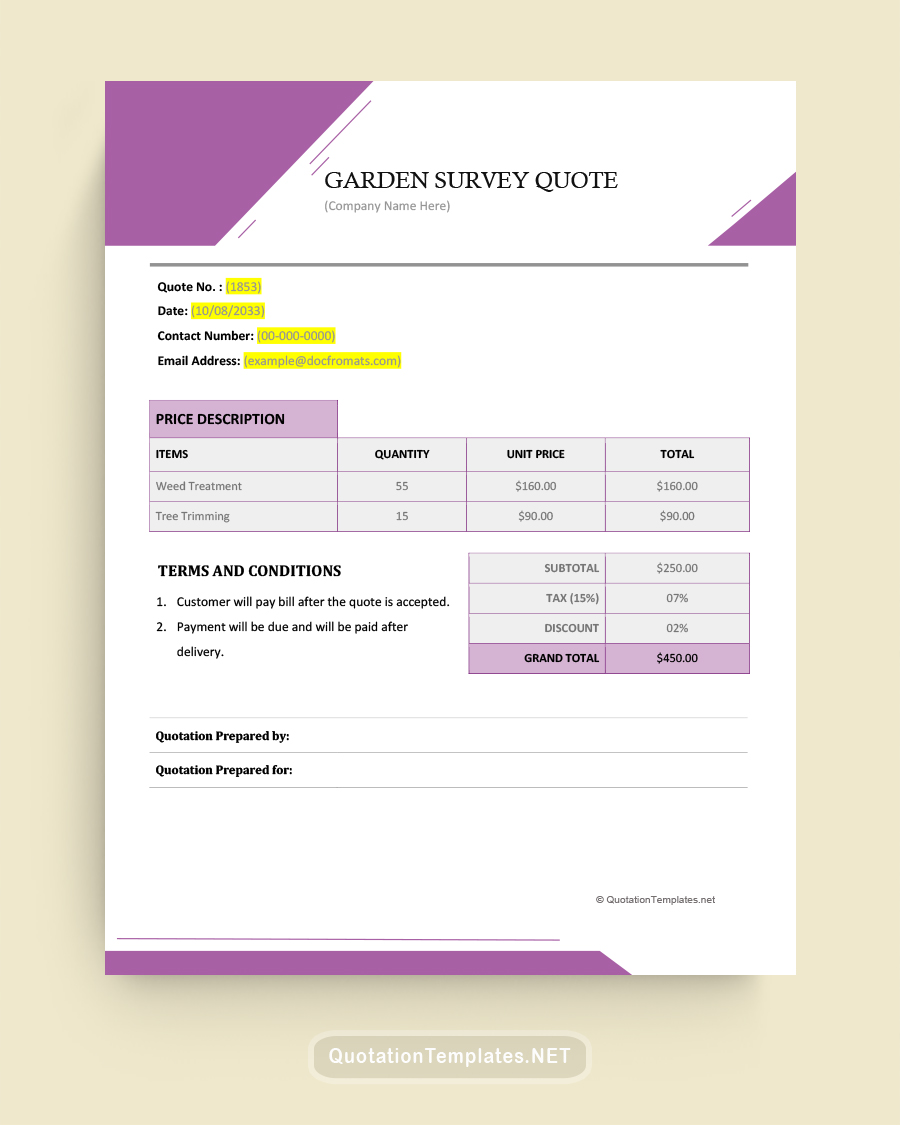
A landscaping quote template is a fillable format that offers numerous advantages to businesses, making it an invaluable tool in their operations. It provides a standardized framework, enabling businesses to present consistent and well-organized quotes to clients. The consistency of a well-written format enhances professionalism and credibility, building trust among potential customers. Moreover, using a template significantly speeds up the quoting process. With predefined sections and prompts, businesses can quickly input relevant information and generate accurate quotes in a timely manner. The structured layout of the template ensures that all crucial details, such as service descriptions, pricing, and terms, are systematically included, reducing the likelihood of errors or omissions. Ultimately, using a landscaping quote template significantly contributes to the overall success and reputation of the business.

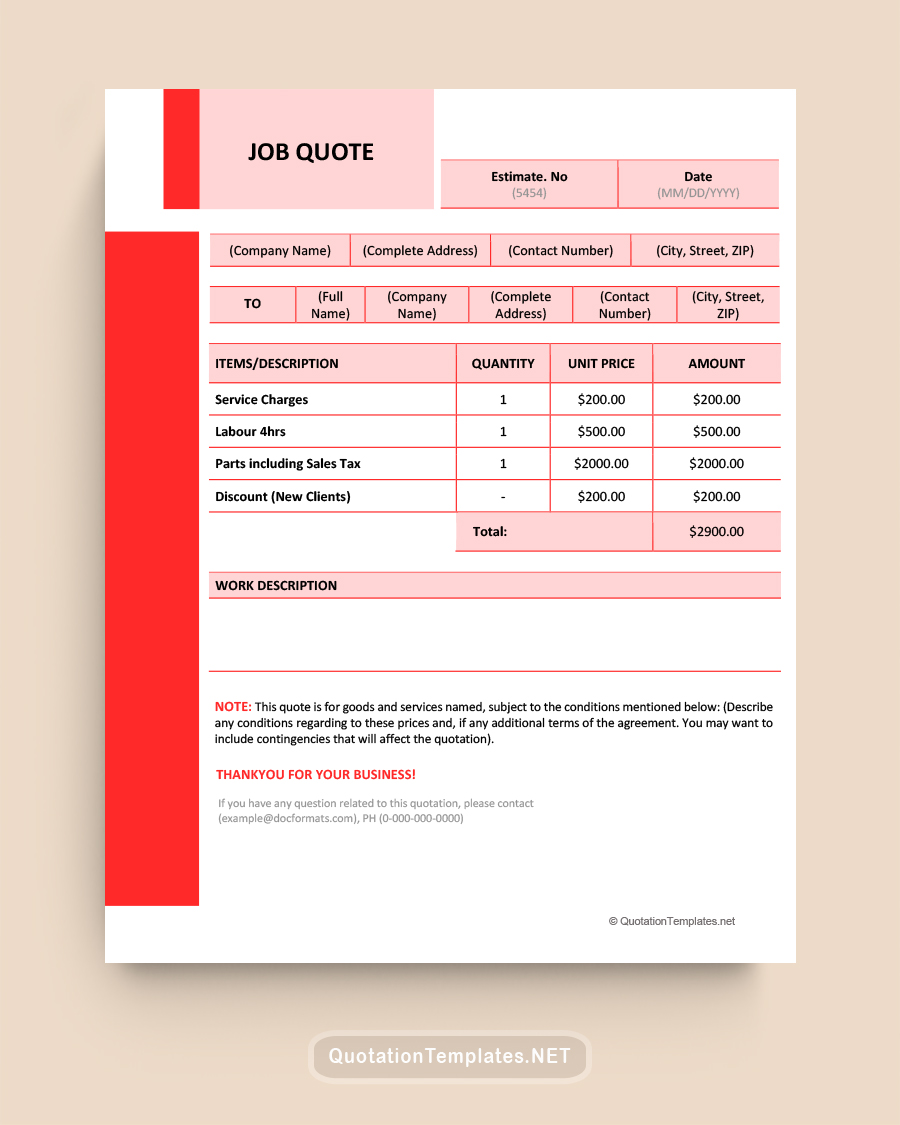
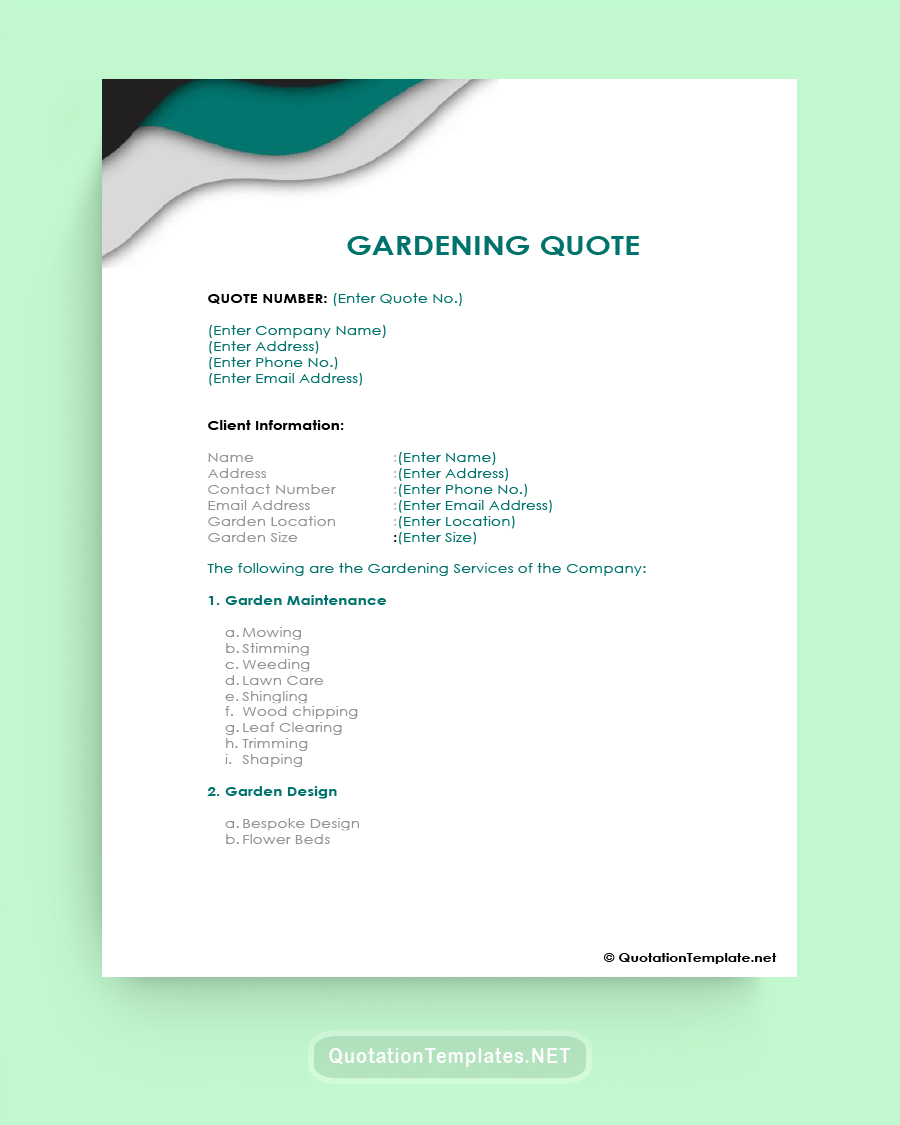
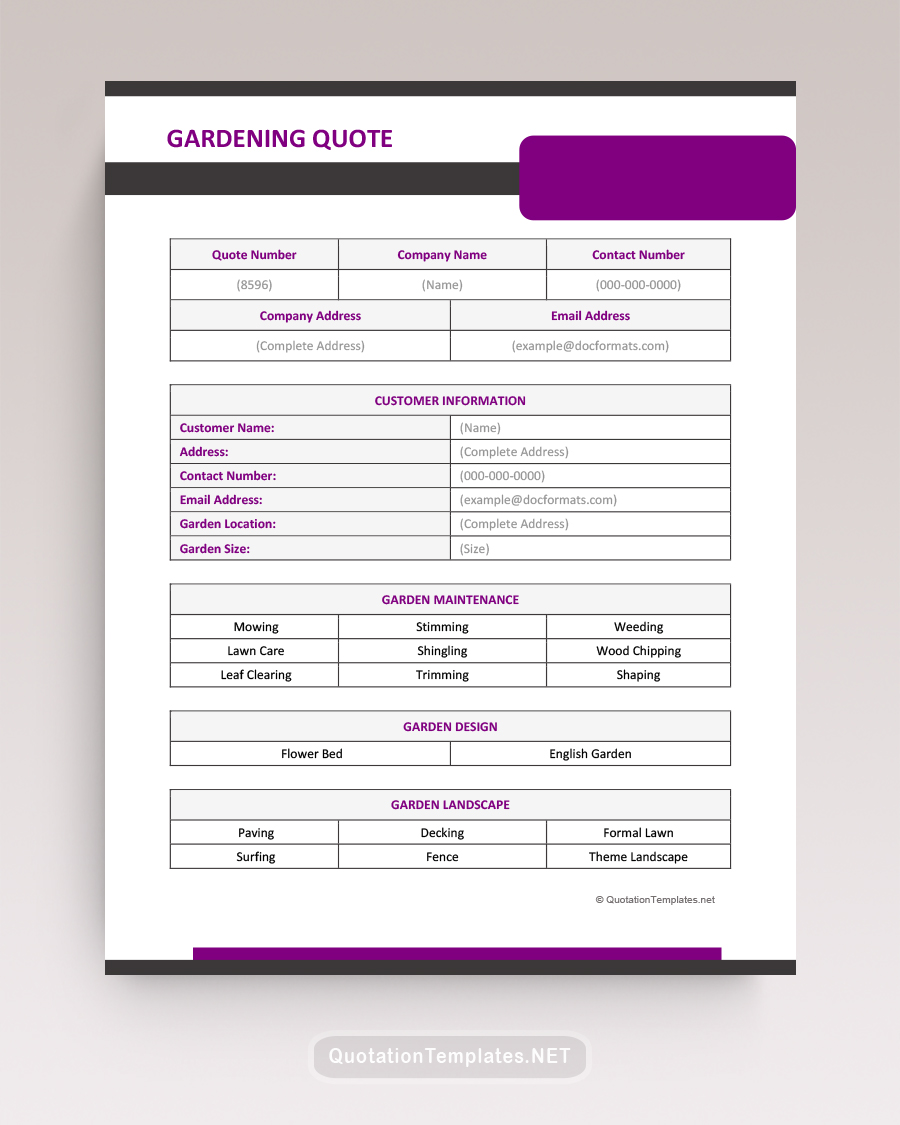
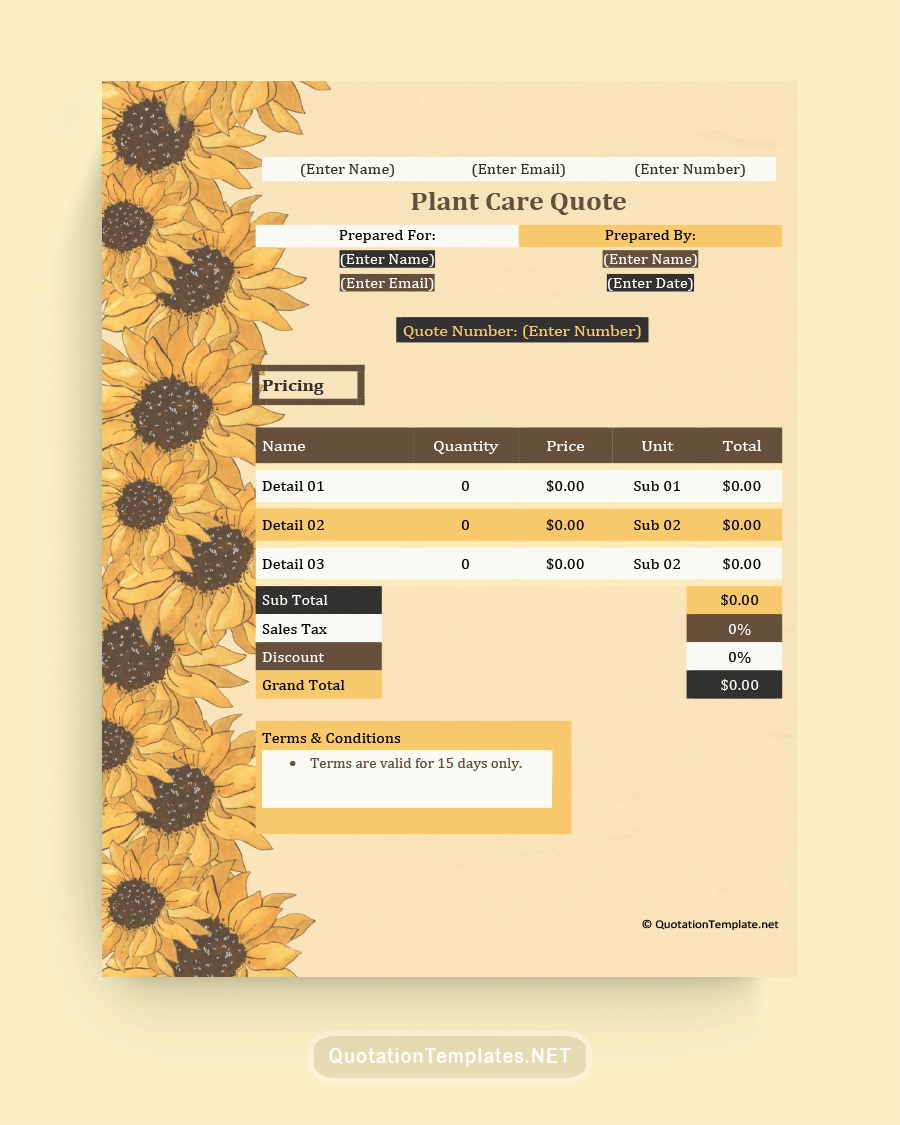
A landscaping quote template is a pre-designed document that provides a structured framework for creating quotes in the landscaping industry. It typically includes sections for important details such as client information, service descriptions, pricing, terms and conditions, and any additional notes or specifications. The template serves as a starting point for landscapers to input specific information and customize the quote according to the client’s needs. It ensures consistency in formatting and content, making the quoting process more efficient and professional.
Fun Fact: Did you know that using templates for landscaping quotes dates back to ancient times? In ancient Rome, architects and landscape designers used stylus and wax tablets to create standardized templates for their designs and estimates. These templates consisted of pre-drawn elements such as trees, plants, and architectural structures, which could be easily replicated and customized for different clients. This early form of template-based design and quoting allowed ancient Roman landscapers to communicate their ideas and provide estimates for their clients efficiently.
A landscaping quote template is important for several reasons. Firstly, it enables landscapers to present consistent and well-organized quotes to clients, enhancing professionalism and credibility. The template ensures all necessary information is included and properly formatted, leaving a positive impression on potential customers. Additionally, a landscaping quote template saves time and effort by providing a ready-made structure. Instead of starting from scratch for each quote, landscapers can use the template as a blueprint and customize the specific details. This streamlines the quoting process and allows landscapers to generate accurate quotes more quickly.
Important Note: It is crucial to regularly review and update your landscaping quote templates to ensure they accurately reflect your current pricing, services, and terms. As your business evolves, you may introduce new services, adjust pricing structures, or modify your terms and conditions. By keeping your quotes current, you avoid potential discrepancies or misunderstandings. Additionally, regularly reviewing your templates allows you to identify areas for improvement, such as streamlining the layout or adding new sections to serve your clients’ needs better. Maintaining accurate and relevant landscaping quote templates demonstrates professionalism, consistency, and attention to detail, ultimately contributing to the success and reputation of your business.
To ensure a comprehensive and professional quote, certain essential elements should be included in the template. These elements cover company and client information, project details, material and labor costs, equipment rentals, payment terms, and acceptance statements. A landscaping quote template should include the following essential elements:
Pro Tip: When creating landscaping quote templates, consider including a section for optional add-on services or upgrades. This allows you to present additional offerings to your clients, giving them the opportunity to customize their landscaping project according to their preferences and budget.
When writing a landscaping quote, there are several key steps to follow:
Gather necessary information: Collect details about the client’s requirements, including the project scope, specific services needed, materials, and any other relevant specifications.
Calculate costs: Estimate the costs involved, including labor, materials, equipment, and additional expenses.
Determine pricing: Decide on a pricing strategy, whether it’s based on hourly rates, fixed project fees, or a combination of both.
Structure the quote: Use a landscaping quote template or create a document with sections for client information, service descriptions, pricing, terms and conditions, and other pertinent details.
Input information: Fill in the template or document with the gathered information, ensuring accuracy and clarity.
Review and proofread: Double-check the quote for errors or inconsistencies before sending it to the client.
Send the quote: Provide the completed landscaping quote to the client and any additional materials or explanations if necessary.
The hourly rate charged by landscapers can vary depending on factors such as location, experience, scope of work, and market demand. On average, landscapers may charge anywhere from $40 to $100 per hour. However, it is essential to note that this range is not definitive and can differ significantly based on regional variations and specific circumstances. Landscapers should conduct market research and consider their costs, expertise, and competitive positioning when determining hourly rates.
What is the formula for landscaping estimate?The mathematical formula for a landscaping estimate involves a combination of calculations and variables specific to the project. While there is no single formula that universally applies to all landscaping estimates, here are some common mathematical considerations:
Area Calculation: Measure the area to be landscaped (e.g., square footage) and use it as a basis for various calculations.
Material Cost Calculation: Determine the quantity and cost of materials required for the project, such as plants, soil, mulch, rocks, or hardscaping elements. Multiply the quantity by the cost per unit to calculate the material cost.
Labor Cost Calculation: Estimate the number of labor hours needed to complete the project and multiply it by the hourly rate for labor. This will give you the labor cost.
Equipment Cost Calculation: If specialized equipment is required, consider the cost of renting or operating it. Add this cost to the estimate.
Overhead Expenses: Include overhead costs such as administrative expenses, insurance, transportation, and any other indirect costs associated with the project.
Profit Margin: Determine the desired profit margin percentage and apply it to the total estimated costs to include the profit in the final estimate.
Businesses can present a cohesive and polished image to their clients with a predefined template structure and format. Furthermore, a landscaping quote template streamlines the quoting process by providing a ready-to-use framework, saving valuable time and effort for the business. The template allows for quick customization with specific details, such as services offered, pricing, and terms, ensuring accurate and comprehensive quotes. Moreover, a template enables businesses to maintain accurate records of past quotes, facilitating easy reference and analysis for future decision-making and strategizing. Overall, a landscaping quote template enhances efficiency, professionalism, and record-keeping for businesses in the landscaping industry.